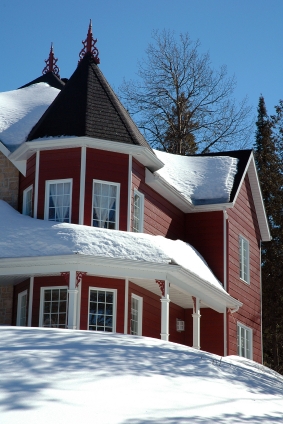During the winter season, ice dams can build up in gutters and roof edges. This is caused by snow that melts on the eaves during the day and refreezes at night. When snow accumulates, water from the melting snow does not drain properly; it instead causes water to leak into the building structure. To prevent the accumulation of heavy snow and ice on the roof, heat tape can be installed. This is an effective tool for de-icing roofs, eaves, and gutters in order to facilitate the proper drainage of water and save the structure from any damage that could be caused by winter weather.
during the day and refreezes at night. When snow accumulates, water from the melting snow does not drain properly; it instead causes water to leak into the building structure. To prevent the accumulation of heavy snow and ice on the roof, heat tape can be installed. This is an effective tool for de-icing roofs, eaves, and gutters in order to facilitate the proper drainage of water and save the structure from any damage that could be caused by winter weather.
Installation Process
Heat tape is a de-icing cable that is fastened in a zigzag or inverted “V” shaped pattern to the edges or valleys of the roof, the areas most prone to the formation of ice dams. The cables should be fastened securely to the existing roofing material so they do not slide off due to large amounts of snow in the gutters. Aside from the zigzag pattern, this de-icing cable should be run in line with the gutters and inside all downspouts to ensure that no ice forms in these components, which in turn facilitates the free flow of water. Although installing de-icing cables is a good investment, it is a moderately challenging job because of the requirement to climb a ladder and move about on the roof and eaves troughs. Fortunately, this is a job that professional roofers can perform both rapidly and safely.
Sizes
These heating cables come in various sizes and are available at major hardware stores. Lengths run from 30 to 100 feet in length. They are designed to turn on when the temperature falls below 40 degrees Fahrenheit to prevent ice and snow from the building. Most heat tape is run with 120 volts of electrical power; however, there are also cables that use from 240 to 600 volts of power. The higher voltage heat tape is installed mainly for extreme cases and for industrial use. For most residential applications, 120 or 240 volts is all that is needed.
Another term for increasing the surface temperature in a given area is called trace heating. This prevents any freezing ice and/or snow accumulation. When buying this type of heat tape, the package includes a thermostat that controls the temperature and switches the cable on and off when the temperature goes below the 40-degree range; other types of heat tape do not have thermostats. Installation is very simple but does differ from one brand to another. Therefore, it is imperative to follow the manufacturer’s instructions accurately.
Safety Precautions
Since de-icing tape uses electricity, it poses a risk of fire due to the possibility of a short circuit. For this reason, there are safety guidelines that should be followed to avoid any property damage.
- Manual – Always read the manufacturer’s manual.
- Wires – Some electric cables should not cross or come in contact with each other to prevent overheating or ignition unless the manufacturer specifically guarantees this will not happen.
- GFCI – Always use a ground fault circuit interrupter (GFCI) as the power source for the installed heating cables.
- End-Caps – Insulate the end-cap of the cables to avoid water penetration that could cause a short circuit and possible fire ignition.
- Controls – Temperature controllers should be installed based on the manufacturer’s advice.
- Cables – Electric cables that are older than three years, discolored, cracked, or damaged should be immediately replaced.
Those who live in northern climates and receive heavy snow should have heat tape installed. Although this is not mandatory, it is highly recommended. It will prevent the formation of ice dams and keep water from penetrating the building and causing major damage. The cost of installing this preventive tool is a wise investment compared to the damage that could be caused by the massive accumulation of snow on eaves troughs valleys and downspouts. Although this device can be installed by non-professionals, it is still recommended to seek the help of professional roofing contractors to ensure complete safety and accuracy of the installation process. Heat tape is indeed a useful tool to prevent roof damage in wintry climates!
Do you have a Woodlands roof that needs some attention? Schulte Roofing of The Woodlands provides professional service to the entire area north of Houston and can help customers with any roofing problems!
